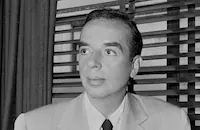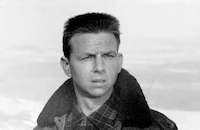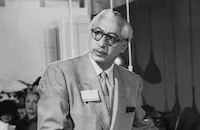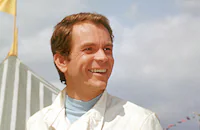Designing Woman

Brief Synopsis
Cast & Crew
Vincente Minnelli
Gregory Peck
Lauren Bacall
Dolores Gray
Sam Levene
Tom Helmore
Film Details
Technical Specs

Synopsis
At the Beverly Hills Hotel, after a long night of drinking, sports writer Mike Hagen is hung over and anxious because he cannot recall writing his New York Record assignment that was due the previous evening. When fashion designer Marilla, whom Mike does not recognize, informs him that they actually wrote the story together and then attempts to return the $700 Mike paid her for her help, Mike, charmed by the spunky woman, insists that they spend the money together vacationing in California. After a whirlwind courtship, the couple marries and returns to New York, where Mike abandons his small, cluttered apartment for Marilla's East Side abode, site unseen. While packing Mike's apartment, Marilla finds a picture of woman caught in a seductive pose, but disregards it to avoid any conflict. At the newspaper office, editor Ned Hammerstein warns Mike that crooked boxing promoter Martin J. Daylor has placed several calls threatening Mike's life because of the reporter's articles about Daylor's racket. Later, Mike lunches with his previous girl friend, actress Lori Shannon, and announces his recent marriage. Lori soon grows angry at Mike's effusive descriptions of Marilla and tips a plate of ravioli in his lap. As Lori storms out of the restaurant, Marilla arrives and suspects the accident was caused by something other than his carelessness. After changing into a pair of short busboy pants, Mike returns with Marilla to her upscale apartment, where they walk into a surprise wedding shower thrown by Marilla's friends. Mike is embarrassed by his attire and contemptuous of the ceremonious gentility of the actors, artists and designers who surround Marilla while ignoring him. The only guest to befriend Mike is Broadway producer Zachary Wilde, whom Mike shuns when he realizes Zachary is Marilla's ex-boyfriend. Later, Marilla apologizes for her friends's behavior and tearfully defends her job to a stunned Mike. For several weeks the couple are quite happy while managing to keep their professional worlds apart. Then one night, Marilla attends a boxing match with Mike, where she is overwhelmed by the brutal fight, Daylor's threats and informant Charlie Arneg's demands for more money for information. The following week, Mike and his cronies gather at the apartment for their weekly poker game while, in another room, Marilla holds a reading of Zachary's musical, for which she has been chosen to design the costumes. The evening turns into a fiasco when dimwitted ex-boxer Maxie Stulz scares Marilla with his violent boxing stories and choreographer Randy Owen accidentally upturns the poker table with his wild dance steps. After everyone leaves, Mike mocks Randy for his effeminate behavior, but the dancer suddenly returns and offers to fight Mike over the incident. Marilla jokes that Randy is as punchy as Maxie, thus relieving the conflict. Days later, Mike attends Marilla's haut couture fashion show and finds Lori, the musical's new star, at his wife's table. Both he and Lori act as if they have never met, but when Mike bolts from his chair thinking Lori is about to dump her food again, Marilla becomes suspicious. During a subsequent rehearsal, Marilla finally concludes that Mike and Lori have had an affair when she recognizes Lori as the woman in the seductive picture. Meanwhile, at Marilla's apartment, Johnny O and several other Daylor henchmen try to force Mike to stop writing the articles by punching him. When Marilla walks in, Mike makes an excuse for his bloody lip and introduces the henchmen as his friends. After they leave, Marilla admits to previous romantic relationships hoping Mike will acknowledge his relationship with Lori, but Mike does not confess. When Marilla accuses him of lying, Mike denies the affair and leaves abruptly. At the office, Ned suggests Mike hide out to evade the gangsters while finishing his exposé on Daylor's boxing racket. He assigns Maxie to protect Mike, ordering the boxer to punch anyone who looks "cross-eyed" at Mike. After telling Marilla that he is leaving town to follow the Yankees, Mike checks into a seedy hotel with Maxie. On the couple's first night apart, Mike contends with the over-protective Maxie, who sleeps with his eyes open, while Marilla fantasizes that Mike is continuing his affair with Lori. The next day, Marilla begs Zachary to interrogate Lori, but Zachary asks the actress to dinner instead and later assures Marilla of Lori's innocence. Over the next few weeks, Mike calls Marilla from the hotel, claiming to be in various cities, while he continues to write about Daylor. Meanwhile, at Daylor's hangout, the racket boss has deduced that Mike is hiding in New York and sends his henchmen to find him. One night, when Marilla calls Mike and threatens to confront Lori herself, Mike tells her to do so. Mike then tricks Maxie into falling asleep, slips out of the hotel and rushes to Lori's apartment. He has concocted a story about how he and Lori briefly met, thus explaining the picture, but Lori assures him that Marilla will not believe the lie. Suddenly, Marilla arrives at the apartment, forcing Lori to hide Mike in her bedroom. As Marilla enters the apartment, Lori's poodle jumps into her arms, disarming her, but when the dog later comes out of the bedroom carrying Mike's shoe, Marilla follows the dog back to Mike. Outraged by his betrayal, Marilla runs from the building. Meanwhile, Maxie wakes up and, finding Mike gone, loudly calls his name out in the lobby, where Charlie overhears him. Upon locating Mike, Charlie, who has discovered that Daylor plans to kidnap Marilla during the opening night of the musical in Boston, offers to sell him the information. After Charlie tells him about Marilla's danger, Mike places a call to the Boston stage to warn her, but she ignores his pleas. While Maxie and Mike catch the next plane to Boston, Lori, whose costume Marilla is aggressively altering with her scissors, finally admits to the affair with Mike. She suggests to Marilla that she accept Mike's story because he is only trying not to hurt her. Marilla leaves the dressing room satisfied that her husband meant no harm and longs to reunite him. When Johnny O suddenly appears, Marilla, still assuming he is one of Mike's friends, accepts his offer to take her to Mike immediately. Mike and Maxie arrive just as Johnny and several other henchmen are forcing Marilla into their car. When a fistfight ensues, Mike yells "cross-eyed," inciting Maxie to punch everyone, including Zachary and the stagehands who are trying to help. Randy then leaps into action, knocking out all the henchmen with his acrobatic footwork and thus establishing his masculinity. When Mike finally tells Marilla the lie about his relationship with Lori, she lovingly accepts it as a token of his true devotion. Months later, Zachary and Lori are happily engaged while Maxie continues to insist he is making a comeback. With Daylor behind bars and his underworld business destroyed, Mike and Marilla enjoy their marriage and each other's differences.

Director

Vincente Minnelli
Cast

Gregory Peck

Lauren Bacall

Dolores Gray

Sam Levene

Tom Helmore

Mickey Shaughnessy

Jesse White

Chuck Connors

Edward Platt

Alvy Moore

Carol Veazie

Jack Cole
Richard Deacon
Casey Adams
George Cisar
Syl Lamont

Mel Welles
Eddie Simms
Charles Hicks
Rodney Bell
Chuck Webster
Gene O'donnell
Jack Daly
Reid Hammond
Wilson Wood
Jack Shea
Walter Johson
Jack Gargan
Helen Eby Rock
Lillian Powell
Donald Kerr
Lomax Study
Saverio Lomedico
Jean Dante
Anthony Jochim
Alice Markham
Jan Arvan
Don Orlando
Mario Siletti
Ed Haskett
Paul Power
Nora Marlowe
Gil Stuart
James Douglas

Benny Rubin
Don Burnett
Ralph Gamble
Max Power
Phyllis Blanchard
Jo Gilbert
Ruth Clifford

Ann Morriss
Patricia Morne
Helen Andrews
Jane Lynn
Betty Koch
Honey King
Jackie Blanchard
Pat Jones
Maruja Ploss
Kay Mansfield
John V. Connors
Allen Ray
Stuart Holmes
Otis Bigelow
Michael Ferris
Jeane Wood
Theona Bryant
Charles Horvath
Bob Morgan
Kay Kuter
Hazel Boyne

Geraldine Wall
Jack Lomas

Sid Melton

Sammy White
Matt Moore

Dean Jones

May Mcavoy
Ann Staunton
Walter Johnson
Joe Mcguinn
Sid Kane
Mushy Callahan
Cy Malis
Madge Blake
Harriet Brest
Eva Pearson
Crew
John Alton
Preston Ames
Mushy Callahan
Barrie Chase
Jack Cole
William Dorfman
Herbert Edwards
Adrienne Fazan
Henry Grace
Sydney Guilaroff
Charles K. Hagedon
Billy Higgins
William A. Horning
Dr. Wesley C. Miller
Warren Newcombe
W. Benton Overstreet
André Previn
Helen Rose
Helen Rose
Dore Schary
William Shanks
William Tuttle
Wally Wallace
George Wells
George Wells
Edwin B. Willis

Photo Collections
Videos
Movie Clip




Trailer
Film Details
Technical Specs

Award Wins
Best Original Screenplay
Best Writing, Screenplay
Articles
Designing Woman
The movie was the brainchild of Oscar®-winning studio designer Helen Rose, who dreamed up a romantic conflict in the style of the Spencer Tracy-Katharine comedies, this one focusing on a sportswriter and a high-style fashion designer who fall in love and marry despite wildly different outlooks and lifestyles. George Wells developed Rose's idea into a breezy script that would win an Academy Award as Best Story and Screenplay. Studio head Dore Schary chose to produce the movie, which turned out to be his last for MGM before he was dismissed from the studio in late 1956.
The original plan had been to reunite Kelly with James Stewart, her co-star from Rear Window (1954), under the direction of Broadway hit-maker Joshua Logan. Cyd Charisse was inked in for the third key part, a musical-comedy star who competes for the sportswriter's affections. After Kelly fled to enact her own real-life Cinderella story, Gregory Peck and Vincente Minnelli came on board as male star and director. When Minnelli gave Peck his choice of leading lady, he asked for Bacall - a choice that also pleased the director. Because she was a bigger name at MGM than Bacall, Charisse no longer seemed appropriate casting as the second-fiddle female and that part went to Dolores Gray. Naturally, Rose designed the costumes - which included 132 gowns, an average of more than a-gown-a-minute for the 118-minute film!
Minnelli recalled in his 1974 autobiography, I Remember It Well, that during the film of Designing Woman, Bogart was already gravely ill with the cancer that would take his life in 1957. One of Bogart's last outings came on a day when he sailed his yacht to California's Marineland, where Bacall and Peck were filming aboard a sailboat. Minnelli considered that Bacall's role was "one she could sail through - which she did, with never a concession to the turmoil her private life was in at the time."
Producer: Dore Schary, George Wells (Associate)
Director: Vincente Minnelli
Screenplay: George Wells
Art Direction: E. Preston Ames, William A. Horning
Costume Design: Helen Rose
Cinematography: John Alton
Editing: Adrienne Fazan
Original Music: Andre Previn
Principal Cast: Gregory Peck (Mike Hagen), Lauren Bacall (Marilla Hagen), Dolores Gray (Lori Shannon), Sam Levene (Ned Hammerstein), Tom Helmore (Zachary Wilde), Mickey Shaughnessy (Maxie Stultz), Jesse White (Charlie Arneg), Chuck Connors (Johnnie "O").
C-118m. Letterboxed. Close captioning. Descriptive Video.
By Roger Fristoe

Designing Woman
Quotes
We never argue anymore. And when we do, it never lasts more than a week or two.- Marilla Hagen
Why is it that you can't stand the sight of blood on anyone but me?- Mike Hagen
Liquor, I've found, makes me very smart sometimes.- Mike Hagen
So, what's for dinner?- Mike Hagen
Lori Shannon.- Marilla Hagen
For dinner?- Mike Hagen
Trivia
James Stewart and Grace Kelly were intended to be the co-stars of this movie, but when Kelly became betrothed to Prince Rainier of Monaco, Stewart decided not to do it (a decision he later said he regretted), and the leading roles went to Gregory Peck and Lauren Bacall.
George Burns later told Gregory Peck that his reaction to getting the plate turned over in his lap was one of the best of its kind Burns had ever seen.
Notes
George Wells was credited onscreen as follows: "written by George Wells Associate Producer." Following the opening credits, several of the lead characters give individual introductions to the story, addressing the camera directly. Intermittently throughout the film, actors Gregory Peck, Lauren Bacall and Dolores Gray, provide voice-over narration. At the close of the film, several of the lead characters give story epilogues, directly addressing the camera. During the early scene in which "Mike Hagen" is hungover from a night of drinking, every noise is amplified, including the sound of a pin from a new shirt dropping into a wastebasket.
July and August 1955 Hollywood Reporter news items state that Grace Kelly and James Stewart were originally considered for the film, but, according to modern sources, when Kelly refused the part due to her recent marriage, Stewart also declined the production. A March 13, 1956 Hollywood Reporter news item states that Cyd Charisse was then slated to star in the film, but was replaced by Bacall. According to a July 30, 1956 Hollywood Reporter news item, Peck completed the deal to star in the film with Bacall in return for the loan of M-G-M star Ava Gardner to appear in his own independent production Thieves' Market; however, that film was never made. A August 24, 1956 Hollywood Reporter news item states that director Vincente Minnelli tested Jarma Lewis for a role in the film, but her appearance in the film has not been confirmed. Hollywood Reporter production charts add Jesse White, Kip King, Lysa Baugher, Sheila Hackett, Roberta Leune, Edith Udane, Sallie Whalen and Bette Curtis to the cast; however, their appearance in the film has not been confirmed.
Designing Woman was producer Dore Schary's first comedy and last film for M-G-M, the studio at which he had been head of production since the late 1940s. Portions of the film were shot on location at the Beverly Hills Hotel, Beverly Hills, CA; Marineland, CA and in Hollywood, CA.
Wells received an Academy Award for Best Screenplay for his contribution to the film. According to a April 17, 1957 Los Angeles Times article, costume designer Helen Rose received a Golden Hatbox Award for her contribution. Although some modern sources claim that Designing Woman is a remake of the 1942 M-G-M film Woman of the Year and the films's characters and theme bear some similarities, the stories are different. Designing Woman marked the first acting role for choreographer Jack Cole, who had previously worked in film as as a choreographer or onscreen dancer.

Miscellaneous Notes
Released in United States Spring April 1957
CinemaScope
Released in United States Spring April 1957














